A slender crescent Moon is a beautiful and inspiring sight. December and January offer several opportunities to see these exceptional slices in the sky.
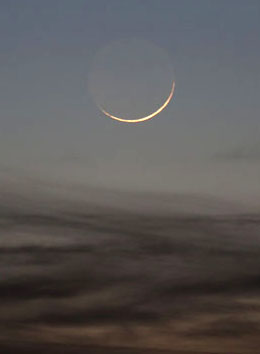
Bob King
When it comes to seeing a young lunar crescent, my personal best is a 21.5-hour-old Moon. That's a far cry from the record, but what a sight. The Moon was fine china, so fragile you might crack it with the slightest touch. Crater shadows took little bites out of the delicate lunar arc, adding to the exquisite view.
This December and in the coming months, we'll have several opportunities to catch youthful crescents at dusk or senior ones at dawn. A few of these will be extremely challenging, others easier but just as remarkable to behold.
A day-old crescent isn't too difficult to see and a worthy goal for the naked-eye observer. The visibility of young (or old) crescents has much to do with the angle the Moon's path makes to the horizon.
The Moon basically follows the ecliptic, the same path traveled by the Sun and planets. From mid-northern latitudes in late summer and fall, the ecliptic tilts upward at a very shallow from the sunset horizon, so thin crescents barely escape the solar glow and are difficult or impossible to see.
From winter through mid-spring, however, the lunar byway tilts upward at an ever-steeper angle from the western horizon, placing the Moon higher up in the sky and offering us a better view. The opposite situation rules at dawn, with summer and fall the best times to seek the waning crescent.
Because the Moon's orbit is tipped relative to the plane of Earth's orbit, it can range up to 5° north or south of the ecliptic. If the crescent occurs around the northern extreme, visibility is improved for mid-northern latitude observers and similarly for southern observers at its southern extreme.
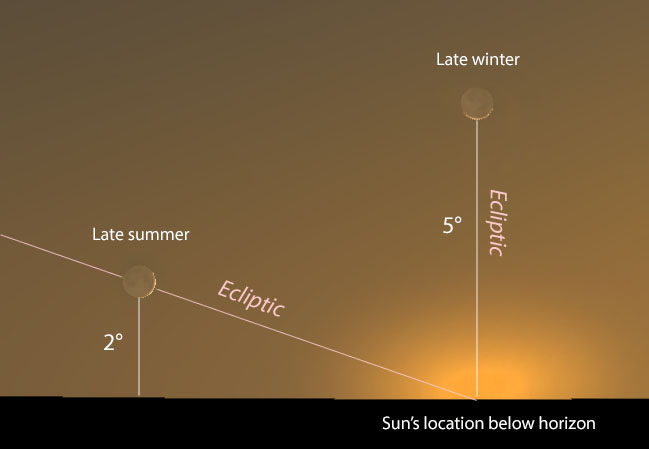
Stellarium / Bob King
Essential to seeking young and old crescents is knowing the date of New Moon and time of sunset / sunrise. This month, new Moon occurs at 1:30 a.m. Eastern Standard Time (6:30 UT) December 18th. Because a crescent's age depends on your location, in this article we'll feature its visibility across North American time zones. I ask forgiveness from European and other observers and encourage you to use the listed times of new Moon at the end this article to determine your own best crescents.
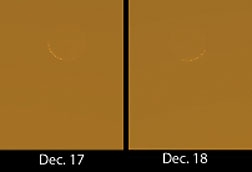
Stellarium
On the December 17th, the morning prior to new Moon, observers in the central and southern U.S. might see a micro-thin waning crescent just 2° to 3° high in the southeastern sky 35 to 20 minutes before sunrise. From the eastern U.S., the Moon would be just 18.5 hours before new phase. From the Central time zone, 17.5 hours; 16.5 from the Western states; and 15.5 from the West Coast. The farther east you live the easier it will be to see the early new Moon. To attempt this tantalizing challenge, you'll need clear, haze-and-cloud-free skies, a completely open view to the southeast, and a pair of binoculars. If you have access to a mountaintop or a tall hill, all the better.
Prefocus the binoculars at infinity on a bright star earlier that night or point them at the planet Jupiter, well up in the southeastern sky in morning twilight. Start your sweeps to the right of the brightest twilight glow (where the Sun will soon rise) to seek the skinny curve of the lunar crescent. Once you've found it, slowly lower the binoculars while focusing your gaze at the Moon's location to see if you can discern it without optical aid.
For a shot at the evening crescent on December 18th, find a location with a view as close to the southwestern horizon as possible and start searching about 20–25 minutes after sundown. Here are the Moon's ages (give or take) depending on where you live — East Coast: 15.5 hours; Central: 16.5 hours; Mountain: 17.5 hours; and West Coast: 18.5 hours.
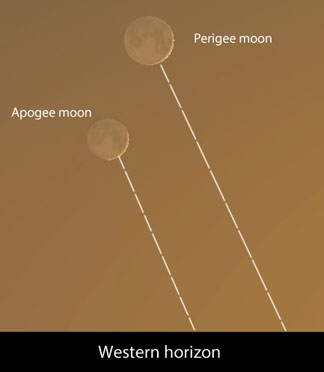
Stellarium / Bob King
During both events, the Moon's distance from the Sun varies from about 7.5° to 8.5°. Research done by Louay J. Fatoohi and his colleagues at the University of Durham (paper here) have shown that when the Moon is fewer than 7.5° from the Sun, it's impossible to see due to atmospheric extinction, physiological factors, and the shrinkage of the crescent's length caused by crater and mountain shadows clipping the ends. In December, the waning crescent will be an easier sight for the eastern half of the country with the evening crescent easier for the western half.
Other factors influencing the Moon's visibility include perigee timing. If the crescent occurs around the time of perigee (closest to the Earth), it will move up and away from the Sun into the evening sky more quickly, enhancing its visibility compared to the more "sluggish" apogee Moon.
The record for the youngest Moon sighted with the naked eye goes to amateur astronomer Steven James O’Meara, who nabbed a 15 hour-32 minute crescent in May 1990. Mohsen G. Mirsaeed of Tehran broke the record for youngest Moon ever seen with optical aid on September 7, 2002. He observed from a mountain site using giant 40×150 binoculars and held a razor slice of crescent in view for one minute. At the time, the Moon was just 11 hours, 40 minutes past new and 7.5° from the Sun.
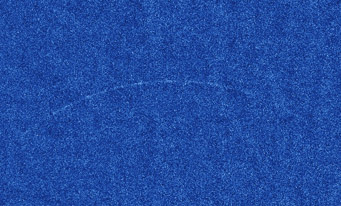
The ultimate record was set on July 8, 2013, by French astrophotographer, Thierry Legault, who photographed the moment of new Moon. The Moon lay just 4.4° south of the Sun at the time, so its extreme northern edge caught enough sunshine to show as a crescent. Only the camera recorded the historical moment as the sky was much too bright to see the Moon even through a telescope.
Keep the following list of exceptionally young Moons handy, so you can try again on other occasions. It's one thing to set a new record for yourself, but in doing so, you'll witness one of the sky's most inspiring sites — a barely-there Moon.
Below is a list of sub-24 hour crescent moons to watch for across North American time zones from mid-northern latitudes (default is 40° N). To help in determining exactly where to look for the evanescent sight in your local landscape, I recommend the Photographer's Ephemeris app for Android and iPhone. You can also create realistic simulations of the Moon's phase and position with a free sky-mapping program like Stellarium.
- New Moon, January 16, 9:18 p.m. EST (2:18 UT January 17). Excellent evening window 30–40 minutes after sunset on January 17th in the southwestern sky. The Moon's age East Coast to West Coast will be 20 hours to 24 hours. This is a great chance to spot a sub-24-hour Moon! Don't forget your camera 🙂
- New Moon, February 15, 4:06 p.m. EST (20:06 UT). No sub-24-hour Moon visible morning or evening.
- New Moon, March 17, 9:14 a.m. EDT (13:14 UT). No sub-24-hour Moon visible morning or evening.
- New Moon, April 15, 9:59 p.m. EDT (1:59 UT April 16). The viewing window is 20–30 minutes after sunset on April 16th for the western sky. The Moon's age East Coast to West Coast will be 21.5 hours to 24.5 hours.
- New Moon, May 15, 7:49 a.m. EDT (11:49 UT). No sub-24 Moon visible morning or evening.
 35
35









Comments
halfastro
December 13, 2017 at 11:39 am
My best with binoculars (8x42) is 13 hours and 46 minutes past new from Cassiopeia Observatory in Oracle, Arizona on January 1, 2014. I instantly turned my camera toward it and captured several pictures. https://www.flickr.com/photos/halfastro/albums/72157639298787074
Universe Today documented our efforts to capture the new Moon that day. https://www.universetoday.com/107700/ultra-thin-young-crescent-moon-sighted-from-u-s-southwest/
I have tried a few times to capture crescents between 12 and 13 hours but without success so far (most recent attempt had some haze from California fires in the way).
You must be logged in to post a comment.
Bob KingPost Author
December 13, 2017 at 4:41 pm
Halfastro,
Wow, what a photo! Congratulations and thank you for sharing your images. I encourage crescent seekers to stop by your Flickr site.
You must be logged in to post a comment.
Joe Stieber
December 13, 2017 at 9:53 pm
My personal record for a young moon is 20 hr 01 min old one on 03-Feb-2011. I might have sighted it a few minutes earlier and broken the 20-hour barrier, but I was distracted by a dog walker who was curious about what I was doing. My closest-to-new moon that finally broke the 20-hour barrier was an old crescent, 19 hr 08 min before new on 28-Dec-2016. In both cases, they were picked up with binoculars, then seen with unaided eyes and captured in photos. Neither is anywhere near a record, but nevertheless, I enjoy chasing thin crescent moons near new, and they are usually sublimely beautiful. My location, not much higher than sea level in the New Jersey suburbs near Philadelphia, probably isn't the best location for finding the thinnest crescents, but one plays the hand that's been dealt.
You must be logged in to post a comment.
Bob KingPost Author
December 14, 2017 at 11:36 am
Joe,
"Distracted by a dog walker" -- what a great detail. That's how touchy these early crescent sightings can be.
You must be logged in to post a comment.
Mark-Moyer
December 14, 2017 at 10:48 am
Won't the ease of seeing a new moon be affected by the Sun-Earth-Moon angle at new moon? That is, since the plane of the Moon's orbit around the Earth is inclined with respect to the plane of the Earth's orbit around the Sun, doesn't that mean that sometimes at new moon the angle will be 0 degrees (e.g. when there's an eclipse) and other times it will much greater (over 5 degrees, if I have it correct). If the moon orbits 360 degrees in ~28 days, that's ~13 degrees, so if the maximal Sun-Earth-Moon angle at new moon is 5 degrees, then just by having an optimal new moon you'll effectively get almost 1/2 day of lighting even when at new moon? I'm not at all sure of this, which is why I'm asking.
As always, I thoroughly enjoyed the article, Bob!
You must be logged in to post a comment.
Bob KingPost Author
December 14, 2017 at 11:34 am
Hi Mark,
Thank you and I'm glad you enjoyed the article. The Moon's 5.1-degree orbital inclination does indeed have an effect on crescent visibility especially around its extremes south or north of the ecliptic. For southern hemisphere skywatchers, a crescent well south of the ecliptic improves visibility just as a crescent at its greatest declination north is easier to spot from mid-northern latitudes. Thank you for pointing this out, and because you did, I added this tidbit to the story to further illuminate the moon's many "moves" that keep us on our toes.
You must be logged in to post a comment.
Graham-Wolf
December 14, 2017 at 8:29 pm
Hi Bob
When I was a full time astronomer at my nation's Carter National Observatory in the late 1980's, I frequently promoted chasing thin Lunar Crescents. I did manage to break 15 hrs twice, with 10x50's,... just. Several of my attempts even made it into the pages of "CASMAG". Back in the day, they were popularised extensively in "Sky and "Telescope". Good on you, Bob, for recreating that international interest again. I think the current record is more like 12 to 13 hours, but it's certainly a tight squeeze.
Good luck and best wishes to those having a go.
Graham W. Wolf at 46 South, Dunedin, NZ.
You must be logged in to post a comment.
December 16, 2017 at 11:25 am
The visual records must be tinged with some doubt I feel, averted imagination is a powerful tool.... I remember trying for a 15hr sliver in perfect skies & strong binoculars but no luck.
You must be logged in to post a comment.
DaemonGPF
December 16, 2017 at 5:19 pm
I have a photo of one at 8 hours, that I took in 2013. Perks of my back yard out in New Mexico.
You must be logged in to post a comment.
Bob KingPost Author
December 16, 2017 at 9:46 pm
Daemon,
Amazing! Is there a link you can share, so we can see the image?
You must be logged in to post a comment.
Anthony Barreiro
December 16, 2017 at 5:39 pm
Thanks very much Bob for explaining the geometry so clearly.
Dramatically thin crescent Moons are thrilling to behold. But the Moon is always beautiful, and her changing appearance from day to day and even hour to hour are endlessly fascinating. The waning crescent Moon, 40 hours before new, rose over my neighbor's roof during dawn this morning, her brilliant crescent cradling glowing earthshine. Took my breath away, even though no heroic effort was required on my part, and I didn't set any records.
You must be logged in to post a comment.
Bob KingPost Author
December 16, 2017 at 9:47 pm
Thanks, Anthony. I agree with your feelings about the Moon and enjoyed your description as well.
You must be logged in to post a comment.
December 16, 2017 at 7:10 pm
My personal record is 14 hours after new, observed with a 7x35 binocular on a very clear evening back in the mid-ninteis outside Boise, Idaho.
You must be logged in to post a comment.
December 16, 2017 at 7:19 pm
Perhaps I should elaborate. Using the [department-store quality] 7x35 binocular, I could trace roughly 120 degrees of the lunar crescent, which appeared as a fragile, broken and beaded thread scintillating against the bright twilight sky. It was a memorable experience, also inspired by an article in Sky & Telescope.
You must be logged in to post a comment.
Bob KingPost Author
December 16, 2017 at 9:54 pm
Hi John,
Excellent! Every time I read of someone spotting such a young moon it encourages me to make the effort. Thanks for sharing your story.
You must be logged in to post a comment.
December 17, 2017 at 5:21 am
At 7.38, this morning from the viewing point I use, the Moon was observed with my binoculars(8×40). Very crisp and clear skies made it possible. Merry Christmas to you all
You must be logged in to post a comment.
Bob KingPost Author
December 17, 2017 at 2:08 pm
Congrats, Jakob 🙂 Cloudy here. Maybe tomorrow evening?
You must be logged in to post a comment.
Chris-Schur
December 17, 2017 at 6:09 pm
HI Bob,
My visual record is not too amazing, 19.2 hours but that was in the 10" at noon. I am bent on tying Thierry's record of imaging the moon at new. To do this, rather than look through a hole in a board on a ladder as he did, I am making a huge long extension tube for the 10 inch to blacken the interior of the scope and block the sun from getting in the tube. Ill keep you updated!
Chris Schur
You must be logged in to post a comment.
Bob KingPost Author
December 17, 2017 at 6:36 pm
Hi Chris,
I'm thrilled you've taken on the challenge. Please let me (us!) know how it goes. If anyone can image this, it's you. Good luck!
You must be logged in to post a comment.
SNH
December 19, 2017 at 4:55 pm
Hey Bob,
Thanks for the article on slim crescent moons. They are awesome aren’t they? I truly believe that it’s a rare sight even for amateur astronomers to spot naked-eye crescents less than 24 hours before/after new since it takes dedication. Seeing my first one was just a truly fantastic sight for me. But since I’ve only seen two, I can’t really even describe my emotions as to how seeing one makes me feel yet! My first was in the morning on December 31, 2013 when I saw a 22.25 hours before new moon. My second was in the evening back on January 28 of this year when I saw a 22.5 hours old moon. I was really hoping that I could see the one on the 17th since it was going to be less than 20 hours before new. Sadly, it rained, and I’m still upset even though we needed it since we here in Arkansas are in an extreme drought.
I will have to try the next one on Jan 16th that you list, even though spotting evening crescents isn’t my forte. I say that because I find it much easier and I have better odds of spotting them in the morning since:
1) I get to first catch sight of the Moon while it’s at its most visible and the sky is at its darkest.
2) I get to see it as it’s getting higher instead of being rushed to catch sight of it before it gets too low.
3) When I stop being able to make it out, I get to record that time instead of when you first spot it in the evening.
4) Earlier in the night I can use my astronomy programs to find a star that will rise in the same location as the Moon, allowing me to know right where to look when it rises. That is not as easy to do in the evening.
But I know that the current records are all in the evening sky. I wonder if because it is harder that’s part of the challenge? Guess I never thought of that before. Well, I’m am not changing because I can never hope to set any records with my horizons blocked a degree of treetops!
Scott
You must be logged in to post a comment.
Ali-Ebrahimi Seraji
December 19, 2017 at 6:02 pm
I've seen a lot of crescents since 2003. The tallest crescent of the New Moon was on December 21, 2014, at 11 hours and 41 minutes. Mr. Mohsen G. Mirsaeed also participated in this observation.
I prepared a table of important observations from 2004 to 2017, which is in the following section.
https://m.facebook.com/story.php?story_fbid=10213912669628875&id=1173117119
I love the slim crescent. I shot two crests with a 0.74 and 0.65 percent phase with a camera and a camera.
https://m.facebook.com/photo.php?fbid=10213912670868906&id=1173117119&set=a.10207064990561178.1073741827.1173117119&source=48
Or this crescent with a 0.9% phase
https://m.facebook.com/photo.php?fbid=10213912775991534&id=1173117119&set=rpd.1173117119&source=49
Best Rigards
Ali
You must be logged in to post a comment.
Bob KingPost Author
December 20, 2017 at 2:50 am
Dear Ali,
Those crescent photos are amazing. The outline is not only a short segment but breaking into pieces. Note: for readers who check out the photo links, click on the "View Larger Image" link on the left side of the page for the best views.
You must be logged in to post a comment.
Ali-Ebrahimi Seraji
December 20, 2017 at 4:30 am
Hi Bob,
Thank you. One part to correct is that two crescent images with a 150 mm telescope have been defeated with a camera Canon 500D.
You must be logged in to post a comment.
Syed Warsi
June 20, 2019 at 4:00 pm
Excellent information. I have a question for Bob King. I have seen on the website on moonsighting.com that the new moon is born on June 3, 2019. Based on the age of the moon, is it possible to see the new moon crescent on June 3rd in Saudi Arabia and or south America on June 3rd evening by using either powerful binoculars and or powerful telescope from the observatory.
I have attached an image from moonsighting.com as follows:
https://www.moonsighting.com/visibilitycurves/1440shw_6-3-2019.gif
Thanks,
Syed Warsi
You must be logged in to post a comment.
Bob KingPost Author
June 20, 2019 at 4:21 pm
Dear Syed,
Thank you for writing. From Saudi Arabia on June 3 at the time of sunset, the moon would have been about 3.5° from the sun and nearly level to it, making it impossible to see visually even with an instrument.
You must be logged in to post a comment.
Sameer_A
May 23, 2020 at 3:59 pm
Hello Bob,
Thanks for this article.
Yesterday May 22 evening, young moon was reported to be sighted in Ethiopia, Somalia, Senegal, Mali et al.
Can you please help in understanding how is this possible when Moonset time there is before or at Sunset time ?
Thanking you in advance.
Kind Regards,
Sameer
You must be logged in to post a comment.
Sameer_A
May 23, 2020 at 4:16 pm
I missed out a key point
Is it possible to sight with naked eye without any special binoculars or equipment ?
You must be logged in to post a comment.
Bob KingPost Author
May 23, 2020 at 4:21 pm
Hi Sameer,
It would not be possible for anyone in Ethiopeia or Somalia (for instance) to see the moon on May 22 around sunset local time because it was very close and below the sun as you mentioned. It will be possible to see it there this evening, May 23 however. Can you point me to the the website where these observations were reported? Thanks!
You must be logged in to post a comment.
Sameer_A
May 23, 2020 at 5:22 pm
Thanks for your quick reply, Bob.
Here’s the excerpt
“ In Somalia, Minister of Religious Affairs and Endowment, Sheikh Nur Mohamed Hassan announced after eight people came forward testifying they have sighted the new moon in the vicinities of Mogadishu, the capital.”
from the news article on website https://www.africanews.com/2020/05/23/muslims-across-east-and-west-africa-observe-2020-eid/
Also some folks in Arizona seem to have sighted the moon, here is the excerpt “Omar Abidi and some others sighted the moon in Phoenix, AZ. This is his number (602) 396-3266 if anyone wants to confirm the information.” from site “ https://m.facebook.com/DarAlTawheedIslamicCentre/posts/3669383669768231”
You must be logged in to post a comment.
Bob KingPost Author
May 23, 2020 at 4:37 pm
Sameer,
Yes, it's possible but the moon was only about 3° from the sun, much too close to see with the naked eye and even most telescopes and binoculars.
You must be logged in to post a comment.
Sameer_A
May 23, 2020 at 5:25 pm
I too have the same opinion but since I am not an expert, I am looking forward to know if there is a gap in my understanding. I have shared the info to your earlier reply. Appreciate the details, Bob.
Thanks,
Sameer
You must be logged in to post a comment.
Bob KingPost Author
May 23, 2020 at 6:18 pm
Sameer,
It just isn't possible for someone to sight the crescent moon just 3° from the sun (as seen from Mogadishu, Somalia on May 22 at sundown) either with naked eye, binoculars or even with most telescopes. One observer in France once photographed the moon AT new moon phase but he used a very sophisticated telescope setup and an infra-red camera to capture the image. The moon was not visible with the eye.
I have to assume the observations were in error. Perhaps people saw something else or imagined it there. The desire to see it first may also have been a factor.
There's no question it will be visible tonight but a little bit challenging.
You must be logged in to post a comment.
Sameer_A
May 23, 2020 at 6:44 pm
Happy to receive your reply, much relief :- )
Thank you very much, Bob.
God bless !
You must be logged in to post a comment.
Nazifa
May 30, 2020 at 8:42 am
Hi Bob,
I am keen to know if there has been any sighting of thin crescent with elongation as less as 6deg, altitude of 4deg, moon age of around 12hrs using any instrument except CCD?
You must be logged in to post a comment.
Nazifa
May 30, 2020 at 5:41 pm
Hi Bob,
Just one more thing in your description above you refer to Elongation limit of 7.5 by Fatoohi and that is is impossible to see beyond that. However, Odeh in 2004, mentions an observation with an ARCL of just 6.5 deg
http://www.astronomycenter.net/pdf/2006_cri.pdf
Kind regards,
You must be logged in to post a comment.
You must be logged in to post a comment.